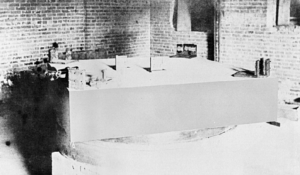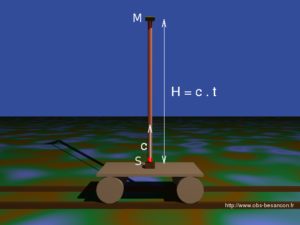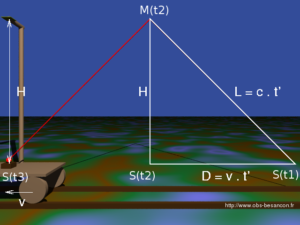Einstein relativity
It has always intuitively seemed to us that there is only one time that prevails in the Universe and that the notions of anteriority, simultaneity and posteriority are valid everywhere. Thus, one can imagine what happens exactly now on a planet of a star of the Andromeda galaxy.
However, at the beginning of the 20th century, Einstein showed us that time depends on the frame of reference in which it is measured, that it is therefore not the same everywhere, and worse, that the notion of simultaneity is not intangible; in short, that time is relative.
Relativity according to Giordano Bruno and Galileo
It has been known since Giordano Bruno [1] and especially since Galileo [2] that speed is a relative concept. This means that a speed has no meaning unless one specifies in relation to what it is measured, which is called the reference frame. Let us hasten to add that this applies to speed but not to acceleration: acceleration is an absolute concept that does not depend on the frame of reference in which it is measured. To be convinced of it, it suffices to feel the effect of a brake stroke inside a vehicle! But let us get back to speed.
If we consider two identical rockets moving towards each other in a uniform rectilinear motion, i.e., in a straight line and at constant speed, we can choose an infinite number of reference frames, all equally valid, to measure their speeds. For example, we can place ourselves at the center of gravity of the two rockets and consider that they are both moving in our direction with the same speed v. But we can also place ourselves in the first rocket, which we will therefore consider immobile, and measure that the second moves towards us with the speed 2v. Likewise, we can choose the frame of reference of this last rocket: now it will be this rocket which will be stationary while the first rocket will move at 2v speed in the opposite direction. And these three points of view are correct, there is none that is more valid than the others. This implies that the notion of zero speed, i.e., absolute rest, is also relative: one can always consider as a reference frame a point which is not subjected to any acceleration. This is called a Galilean reference frame. So, for example, if you are in a train that moves at a constant speed on the tracks, you have every right to consider that you are at rest and that it is the tracks, the stations, the landscape that are moving relative to you. No experience whatsoever, physical or otherwise, will contradict the fact that you are at rest. Unlike the brake stroke example given above, if you are in a car without a window, there is no way to tell if the car is stationary or moving at a constant speed relative to the rails. This physical principle, called Galilean relativity or the relativity of space, was finally accepted by all scientists during the 17th century.
The speed of light is a constant
Around 1865, Maxwell synthesized all the studies that his predecessors had conducted on electricity and magnetism [3]. These works were finally summarized by four equations [4] which, showing that electricity is inseparable from magnetism, encompass what is now called electromagnetism and, beyond that, contain all optics, radio waves, X-rays, etc. Maxwell’s contribution to electromagnetism is completely equivalent to Newton’s contribution to mechanics, i.e., the brilliant synthesis of all previous works in the same unifying framework. And the enthusiasm of the physicists of that time was such that one believed to see the end of theoretical physics, all its fields having been brilliantly solved. However, an apparently small problem appears: in Maxwell’s equations there is a constant, c, which is none other than the speed of light.
But how can a speed, that is to say a relative quantity, which depends on the reference frame in which it is measured, be a constant, therefore absolute? The desire to answer this question will animate theoretical physicists throughout the end of the 19th century and the first years of the 20th century. Among all the attempts to answer this question, the one that will become the majority is that of the ether. Thanks to Maxwell, light is now considered as an electromagnetic wave, but in which medium does it propagate?
Indeed, all known waves propagate in a material medium: water for waves, air for sound and, in general, matter for vibrations. Remove this medium and you remove the wave. It is then considered that the light propagates in relation to the ether, the very one that Aristotle had considered as the 5th element, the one that constitutes everything that is found in the supralunar world. But this hypothetical medium must have singular properties: it has no mass, it crosses matter freely, it is infinitely fluid since it does not oppose any resistance to the movement of the stars, it is perfectly rigid and perfectly elastic since the light is transmitted in a straight line and without attenuation even at considerable distances. But it solves the problem posed by the constant c: it is the speed of light measured with respect to the reference frame of the medium in which it propagates.
Michelson and Morley’s experiment

Almost immediately, an experiment is planned to verify the theory of the ether: to measure the speed of the light from the terrestrial reference frame in the direction of movement of the Earth around the Sun and in the perpendicular direction. This is the Michelson and Morley’s experiment, named after the two physicists who built an extremely sensitive interferometer to highlight a tiny variation in the speed of light (the speed of the Earth around the Sun is 30 km / s compared to 300 000 km / s of light). The two physicists carried out a series of experiments from 1881 to 1887 and finally came to the conclusion that no variation in the speed of light was detected! It is therefore necessary to find another explanation for this constant c which corresponds to the speed of light. However, the theory of the ether will remain until 1920.
Einstein’s two postulates
The solution to this problem was ultimately found by an obscure employee of the Berne patent office, a certain Albert Einstein. He will succeed in reformulating nothing less than the foundations of theoretical physics from two postulates:
- the first is none other than the principle of Galilean relativity formulated above;
- the second, much more original, is the following: the speed of light is independent of the speed of its source [5].
In other words, whatever the frame of reference you are in (and therefore whatever the speed of the light source in your frame of reference), you will always measure a speed of light equal to c. Thus, the speed of light can become a constant and be used as such in Maxwell’s equations. On the other hand, the consequences of these two postulates are at least strange and clearly go against common sense. It is besides all the genius of Einstein (and probably of his first wife Mileva) that to have continued to explore a track which could seem so confusing! The consequence which interests us here and which is not the least by the fundamental change that it imposes in our representation of the world, is called the dilation of times.
Ein gedanken Experiment

Let us take up Einstein’s thought experiment (gedanken Experiment) [5]: we consider a train which moves according to a uniform rectilinear motion with respect to the station platform. In this train, we perform a physics experiment that consists of measuring the time it takes for a light beam to travel vertically back and forth while being reflected on a mirror located at a height H above the light source. Knowing that the speed of light is c (2nd postulate), we deduce that this duration of a round trip will be:
Δt=2H/c.

Now let us imagine that we observe the experiment from the station platform. In this frame of reference, the light beam starts from point A, is reflected at point M and finally arrives at point B. This AM+MB distance traveled by the light is undoubtedly longer than the previous 2H round trip. However, the speed of light is always c in this reference frame (2nd postulate). Consequently, light must travel a longer distance at the same speed: the experiment therefore lasts longer in the reference frame of the station platform than in the reference frame of the train! It suffices to apply the Pythagorean theorem to demonstrate that the duration of the experiment in this frame of reference is:
Δt’=Δt/√1-v²/c².
Of course, the speed of the train is millions of times slower than the speed of light, which makes this effect insensitive. But yet it exists. It has been measured with atomic clocks, one of which remains on the ground while the other travels by plane. The conclusion that emerges from the theory of relativity, a conclusion which has been widely verified experimentally today, is that durations, in other words the flow of time, as well as distances, in other words the distance between two points in space, depend on the reference frame in which they are measured. This is the end of space and time considered as an independent and universal framework in which the world evolves: space and time are linked and each reference frame induces its own space-time. Einstein went even further with general relativity, since he showed that space-time is inseparable from the matter that constitutes the Universe: there is no longer a container independent of its content but a container in total interaction with its content, or even, for the most radical vision, a content without a container [6]!
F. Vernotte, F. Hankard, 18 mai 2021
[1] BRUNO (Giordano). Le banquet des cendres. – Paris : Ed. de l’Éclat, 2006. 1re éd. : 1584.
[2] GALILEI (Galileo). Dialogue concernant les deux plus grands systèmes du monde. – Paris : Seuil, 2000. (Point Sciences). 1re éd. : 1632.
[3] MAXWELL (James Clerk). A Dynamical Theory of the Electromagnetic Field. Royal Society Transactions, vol. 155, 1865.
[4] HEAVISIDE (Oliver). On the Forces, Stresses and Fluxes of Energy in the Electromagnetic Field. Philosophical Transactions of the Royal Society, vol. 183A, 1892.
[5] EINSTEIN (Albert). La théorie de la relativité restreinte et généralisée (mise à la portée de tout le monde). Paris : Gauthier-Villars, 1921.
[6] ROVELLI (Carlo). Et si le temps n’existait pas. – Paris : Dunod, 2014. (Quai des Sciences). 1re éd. : 2006.
